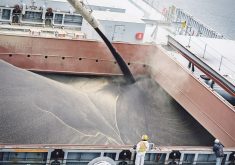Steers drift down
Fed steers last week were off 25 cents per hundredweight, while fed heifers held steady, said Canfax.
Volumes reported by Canfax members were up 37 percent compared to the Canada Day-shortened week, with slightly more than 18,000 head trading.
Even with larger volumes, average prices held near $70 per cwt.
Packer demand was somewhat stronger, but sellers were willing.
In light trade July 8, Alberta steers were $69.50-$71 per cwt., flat rail $119.50 and heifers $70-$71.
The market tone is expected to be similar this week, but the cash market remains volatile, said Canfax. Feedlot showlists are anticipated to increase near the end of the month, reflecting larger placements in late winter and early spring.
Read Also

Russian wheat exports start to pick up the pace
Russia has had a slow start for its 2025-26 wheat export program, but the pace is starting to pick up and that is a bearish factor for prices.
Total offerings might be similar, but more will come from sources outside commercial feedlots.
Only 6,800 head traded at Alberta auction markets, the smallest volume seen all year. That was 18 percent below the week before.
Small volumes at the beginning of the week spurred increased buyer depth at some markets with more numbers mid-week resulting in stronger prices.
A wide range of quality increased the price spread. On average, prices were steady to lower with the exception of 900 lb. steers.
Steers 400-500 lb. traded steady to 25 cents lower, but on light numbers. Steers 500-600 lb. were $1.25 lower, while 600-700 lb. saw the most pressure, down $3.75.
Steers 700-800 lb. were down 50 cents and 800-900 lb. were $1.25 lower. Steers heavier than 900 lb. were up $3.75.
Heifers 500-600 lb. were steady this week, while 600-700 lb. were down $2. Heifers 700-900 lb. traded $1.25-$1.50 lower and 900 lb. and heavier fell 50 cents.
D1, 2 cows were under slight pressure, down 50 cents per cwt. Butcher bulls traded steady.
Feeder volumes low
The week’s feeder trade was a good example of what location and buyer depth can do to the market. It was mid-week before significant volumes were seen at one location, creating more buyer interest from those who were unable to pick up cattle earlier in the week.
Also, buyers were willing to push to get their hands on quality calves. Expect this to take place again until volumes increase, which may take until late August.
D1, 2 cow prices may come under pressure as volumes increase later this summer because packer inventory of mature animals is already large.
Stock-bred cows on limited trade in central and northern Alberta ranged from $400-$625. Bred heifers in northern Alberta traded at $400-$625. Cow-calf pairs were $450-$800 on medium quality and $800-$1,050 on good quality.
Strong demand during the Canadian and American national holidays supported cut-out prices, but sales turned quiet last week.
The U.S. cutout was down $2 US on Choice and $1 on Select.
Canadian wholesale prices this week are steady to slightly lower with Montreal at $138-$142 Cdn and Calgary at $133-$134.
Byproduct values were steady with a stronger undertone in hides and renderings.
Other livestock
U.S. hog markets reflected the holiday-shortened week.
The daily estimated slaughter under federal inspection saw about 279,000 fewer hogs killed than the week before.The U.S. pork cut-out value increased by about $1.67 US per cwt. due mainly to higher wholesale prices for loins, butts and hams.
The Iowa-Minnesota daily direct hog price (plant mean, 51-52 percent, lean carcass converted to live weight) increased slightly to an average of $59.14 per cwt. last week from an average of $58.62 the week before.
Hog prices in Canada drifted a little lower.
Ontario Stockyards reported 2,327 sheep and lambs and 47 goats traded. Light grain-fed lambs sold at $5 per cwt. higher. Heavy lambs held firm.
Sheep traded $2-$5 cwt. higher. The light run of goats also sold higher.














